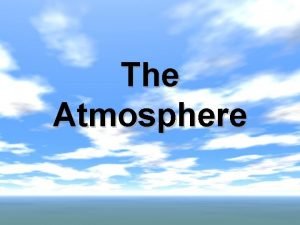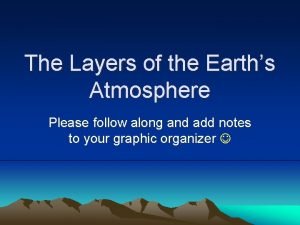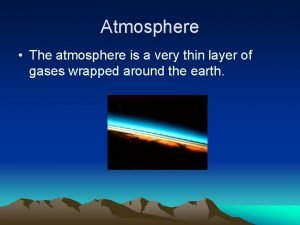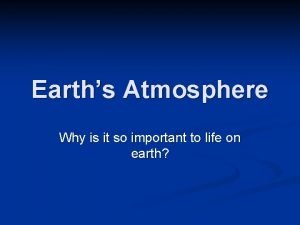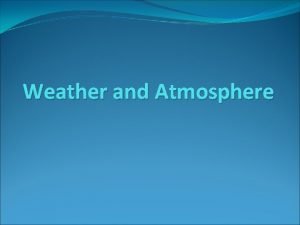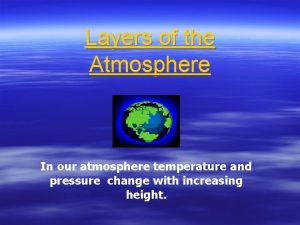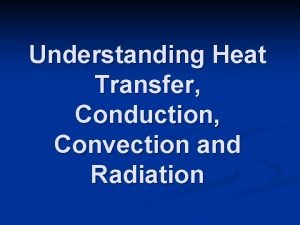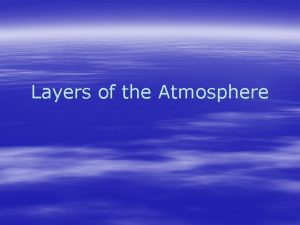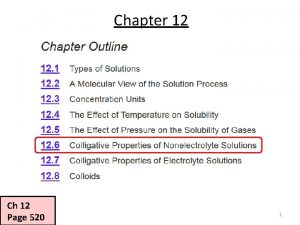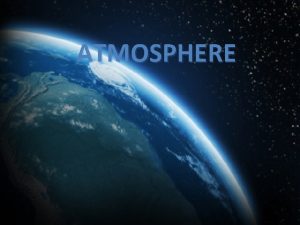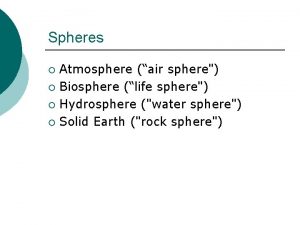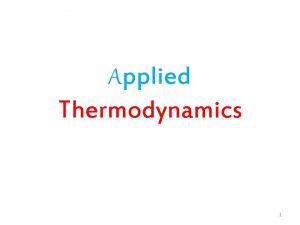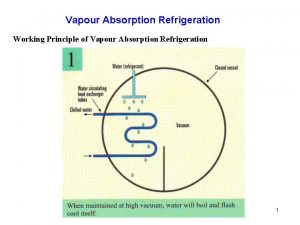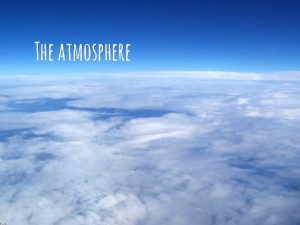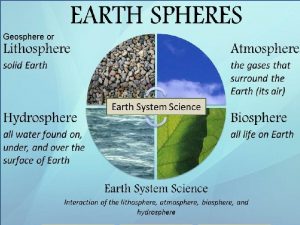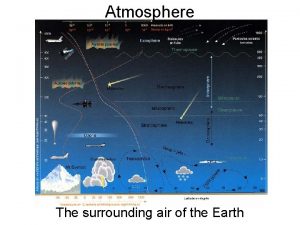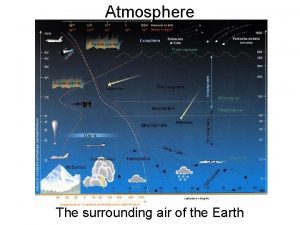ATMOSPHERE ATMOSPHERE VAPOUR SPHERE Layer of air surrounding

















- Slides: 17

ATMOSPHERE

ATMOSPHERE (VAPOUR SPHERE) Layer of air surrounding the Earth Composition of Air (low altitude) 21% 78% Other: etc…

ATMOSPHERE (LAYERS) Exosphere 500 km Thermosphere 80 km Mesosphere 50 km Ozone layer Stratosphere Troposphere 15 km Sea level

ATMOSPHERE (LAYERS) 500 km Troposphere (Sphere of Change) Ø Contains 75% of the mass of the atmosphere. 80 km 50 km Ozone layer Troposphere 15 km Sea level Ø Contains the cloud formations and storms. Ø Temperature and air pressure drop as altitude increases.

ATMOSPHERE (LAYERS) 500 km Stratosphere (Stratified Sphere) 80 km 50 km Ozone layer Stratosphere 15 km Sea level Ø Contains the ozone layer which absorbs harmful ultraviolet radiation from the sun. Ø Temperature increases as altitude increases (due to the ozone layer).

ATMOSPHERE (LAYERS) 500 km Mesosphere (Middle Sphere) 80 km Mesosphere 50 km Ozone layer 15 km Sea level Ø Contains very few air molecules.

ATMOSPHERE (LAYERS) 500 km Thermosphere (Sphere of Heat) Thermosphere 80 km 50 km Ozone layer 15 km Sea level Ø Most of the sun’s rays absorbed in this layer (polar auroras usually form in this layer). Ø International Space Station orbits (altitude ~400 km).

ATMOSPHERE (LAYERS) Exosphere 500 km Exosphere (External Sphere) Ø Extremely few air molecules (almost a vacuum). 80 km 50 km Ozone layer 15 km Sea level Ø Most satellites orbit in this layer.

Atmosphere (to scale) Troposphere (75% of our atmosphere’s mass; includes clouds, etc…) Satellites orbit

Atmospheric Pressure The pressure of the air in the atmosphere Ø The more particles (molecules of air), the higher the pressure High Pressure (Crowded; many molecular collisions) Low Pressure (Molecules further apart; fewer collisions) • Air particles tend to move from high-pressure to low-pressure areas. • This movement gives rise to winds.

Atmospheric Circulation Global movement of air surrounding the Earth Ø Warmer air (less dense) rises above cooler air. Ø Air tends to move from high pressure to low pressure. • Warmer air at the equator tends to rise, leaving behind a lower pressure zone near the surface. • Cooler air moves in from higher pressure areas (from the north and south; this helps balance the temperature on Earth).

Atmospheric Circulation Global movement of air surrounding the Earth Ø Coriolis Effect: Air circulation is also affected by the fact that the Earth is spinning, causing air to take a curved path. (Circulation tends to be clockwise in the northern hemisphere, and counter-clockwise in the southern hemisphere)

Atmospheric Circulation Ø Air Mass: A large portion of atmosphere that has a relatively uniform temperature and humidity. Cold Front Cold air mass moves into a warm air mass. Warm air rises rapidly, cools, forms clouds, and often produces heavy rain.

Atmospheric Circulation Ø Air Mass: A large portion of atmosphere that has a relatively uniform temperature and humidity. Warm Front Warm air mass moves into cold air, rises gradually over the cold air, forming light, stratified clouds. (often results in long-lasting showers)

Energy Resources in the Atmosphere Wind Power Motion Electricity Wind *Energy Electrical Energy * Wind energy (moving air) is a form of kinetic energy

Energy Resources from the Sun Solar Power Light Electricity Solar Energy Electrical Energy

 A thin layer of gases surrounding earth
A thin layer of gases surrounding earth Sphere of control
Sphere of control Hubungan air dengan tanah
Hubungan air dengan tanah The outermost layer of atmosphere
The outermost layer of atmosphere Very thin layer
Very thin layer Layers of atmosphere
Layers of atmosphere Exosphere characteristics
Exosphere characteristics Hottest layer of atmosphere
Hottest layer of atmosphere Outermost layer of the atmosphere
Outermost layer of the atmosphere Hottest layer of atmosphere
Hottest layer of atmosphere What is the first layer of the atmosphere
What is the first layer of the atmosphere A solid brass sphere is initially surrounded by air
A solid brass sphere is initially surrounded by air Partial vapour pressure
Partial vapour pressure Relative lowering of vapour pressure formula
Relative lowering of vapour pressure formula Site:slidetodoc.com
Site:slidetodoc.com Vapour pressure analysers
Vapour pressure analysers Vapour density formula
Vapour density formula Short note on vapour phase refining
Short note on vapour phase refining
